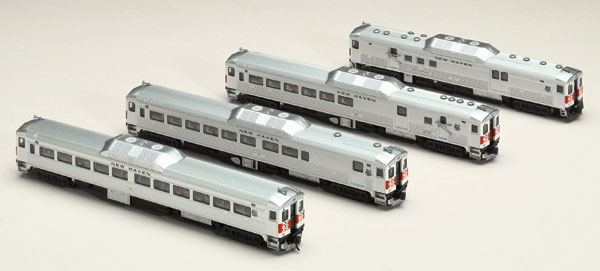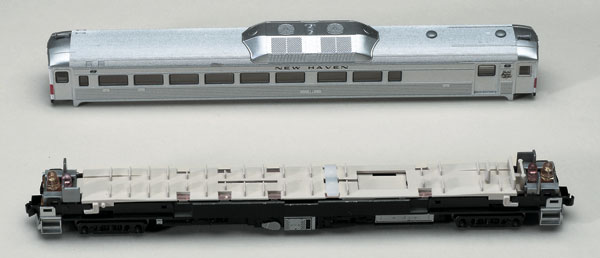That’s because I could look right through the side windows of these well-engineered, DCC-ready models. Taking a design cue from the prototype, Kato has cleverly concealed the motor and drive train within the floor, which preserves the see-through effect.
The Budd Co. introduced its line of self-propelled, stainless-steel RDCs in September 1949 and marketed them as an economical way for railroads to provide passenger service on light-density routes. The New York Central received the first RDC in April 1950.
All RDCs were 85′-0″ long, except the RDC-4 (73′-0″), and each version offered different features starting with the RDC-1 90-seat coach. The RDC-2 was a 71-seat combine with a 17-foot baggage section, the RDC-3 had 49 seats plus a 16-foot baggage area and a 17-foot Railway Post Office apartment. The shorter RDC-4 was a self-propelled RPO with a 30-foot postal apartment and a 31-foot baggage compartment.
Kato’s models represent the early versions of Budd’s RDC-1, RDC-2, and RDC-3, produced from 1950 to 1956, as well as a correctly proportioned early-version RDC-4.
According to Budd Car, The RDC Story (The Weekend Chief Publishing Co.), Budd built 398 RDCs through 1962. The RDC-1 was the most popular with 239 units built, followed by the RDC-2 (67), RDC-3 (48), and the RDC-4 (14). Budd also built 30 unpowered RDC-9 trailers for the Boston & Maine and six special cab cars for the New Haven’s all-RDC Roger Williams trains.
A pair of 275-horsepower General Motors diesel engines powered the RDC through an Allison torque converter driving the inner axle of each truck.
Two long acetal plastic drive shafts connect the universals on the motor shaft and the trucks. Brass worms transfer the motion to all four axles. The wheels are chemically darkened and match National Model Railroad Association standards.
Power is conducted through the wheels to brass bearing plates holding the axle ends. A series of phosphor bronze pickups and internal contact strips transfer the current to the motor.
Digitrax recently has introduced its DN122 Digital Command Control (DCC) decoder, which is designed to fit all four Kato RDC models. Installation involves partially disassembling the model, but no soldering is needed.
The models have directional amber light-emitting diode (LED) headlights and red LED rear marker lights. The effect of the latter is especially attractive. Kato also offers an interior lighting kit as a separate item.
The short-shank couplers are body-mounted and compatible with Micro-Trains and similar knuckle couplers, providing close coupling on curves of 9¾” radius or larger. Kato also includes longer shank couplers for use with tighter curves. Both styles of couplers are designed for manual operation, so if you want automatic magnetic uncoupling, you’ll also need to install the metal trip pins Kato provides.
The couplers on our models were mounted too low, but this shouldn’t be a big problem. Typically RDCs operated alone or in a consist with other RDCs. Although the prototype’s drive train was sturdy, the Budd Co. didn’t recommend using its RDCs to move freight cars. If you follow this prototype practice, the low coupler height won’t be an issue.
The details and dimensions on all four of Kato’s models closely match the prototype drawings published in the September 1967 issue of Railroad Model Craftsman.
The paint on the crisply molded models is evenly applied and the lettering is excellent. The window edges are outlined in black, simulating rubber seals, and the cast-on, painted windshield wipers are well done. The purchaser needs to attach the gray cast-plastic horns, roof-mounted air vents, and the mail hooks which press-fit into holes cast into the RDC-3 and RDC-4. You’ll probably want to paint these parts silver beforehand to match the carbody color.
The black plastic trucks have good relief detail. The radiator assembly is a separate piece that comes installed.
Our models started smoothly and were quiet except at the higher speed ranges. The absence of a flywheel undoubtedly contributes to their proclivity to “get up and go,” a common prototype characteristic. However, our models far surpassed realistic operating speeds. If you use DCC, a loadable speed table and the 128-step feature will provide much more throttle range and more realistic speeds.
I couldn’t see any factory lubrication on our models, so I lightly lubricated the gears, bearings, and motor bearings with plastic compatible oil.
The drawbar pull on the RDC-1, -2, and -3 is equivalent to about 15 40-foot cars on straight, level track. The lighter RDC-4’s drawbar pull equals about seven 40-foot cars. And although they’ll operate on 9¾”-radius curves, the RDCs are long pieces of equipment and will look much better on broader curves.
Apart from the coupler height, Kato’s RDCs are superb models.
Price: $159.98 two-car set;
$79.98 single car
Manufacturer:
Kato USA
100 Remington Rd.
Schaumburg, IL 60173
www.katousa.com
Features:
Directional amber LED headlights and red rear LED markers
DCC ready
Drawbar pull: .64 ounces
(.32 ounces RDC-4)
Engine weight: 2.3 ounces
(2 ounces RDC-4)
Minimum radius: 9¾”
Road names:
Alaska RR
Budd Demonstrator
Canadian National
Canadian Pacific
Chicago & North Western
Jersey Central
New Haven
New York Central
Northern Pacific
Rock Island
Santa Fe
Western Pacific Zephyrette
Undecorated















